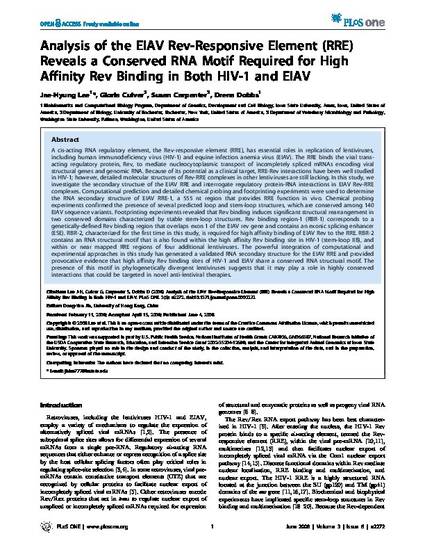
A cis-acting RNA regulatory element, the Rev-responsive element (RRE), has essential roles in replication of lentiviruses, including human immunodeficiency virus (HIV-1) and equine infection anemia virus (EIAV). The RRE binds the viral trans-acting regulatory protein, Rev, to mediate nucleocytoplasmic transport of incompletely spliced mRNAs encoding viral structural genes and genomic RNA. Because of its potential as a clinical target, RRE-Rev interactions have been well studied in HIV-1; however, detailed molecular structures of Rev-RRE complexes in other lentiviruses are still lacking. In this study, we investigate the secondary structure of the EIAV RRE and interrogate regulatory protein-RNA interactions in EIAV Rev-RRE complexes. Computational prediction and detailed chemical probing and footprinting experiments were used to determine the RNA secondary structure of EIAV RRE-1, a 555 nt region that provides RRE function in vivo. Chemical probing experiments confirmed the presence of several predicted loop and stem-loop structures, which are conserved among 140 EIAV sequence variants. Footprinting experiments revealed that Rev binding induces significant structural rearrangement in two conserved domains characterized by stable stem-loop structures. Rev binding region-1 (RBR-1) corresponds to a genetically-defined Rev binding region that overlaps exon 1 of the EIAV rev gene and contains an exonic splicing enhancer (ESE). RBR-2, characterized for the first time in this study, is required for high affinity binding of EIAV Rev to the RRE. RBR-2 contains an RNA structural motif that is also found within the high affinity Rev binding site in HIV-1 (stem-loop IIB), and within or near mapped RRE regions of four additional lentiviruses. The powerful integration of computational and experimental approaches in this study has generated a validated RNA secondary structure for the EIAV RRE and provided provocative evidence that high affinity Rev binding sites of HIV-1 and EIAV share a conserved RNA structural motif. The presence of this motif in phylogenetically divergent lentiviruses suggests that it may play a role in highly conserved interactions that could be targeted in novel anti-lentiviral therapies.
Available at: http://works.bepress.com/drena-dobbs/40/

This article is from PloS ONE 3 (2008): e2272, doi: 10.1371/journal.pone.0002272. Posted with permission.